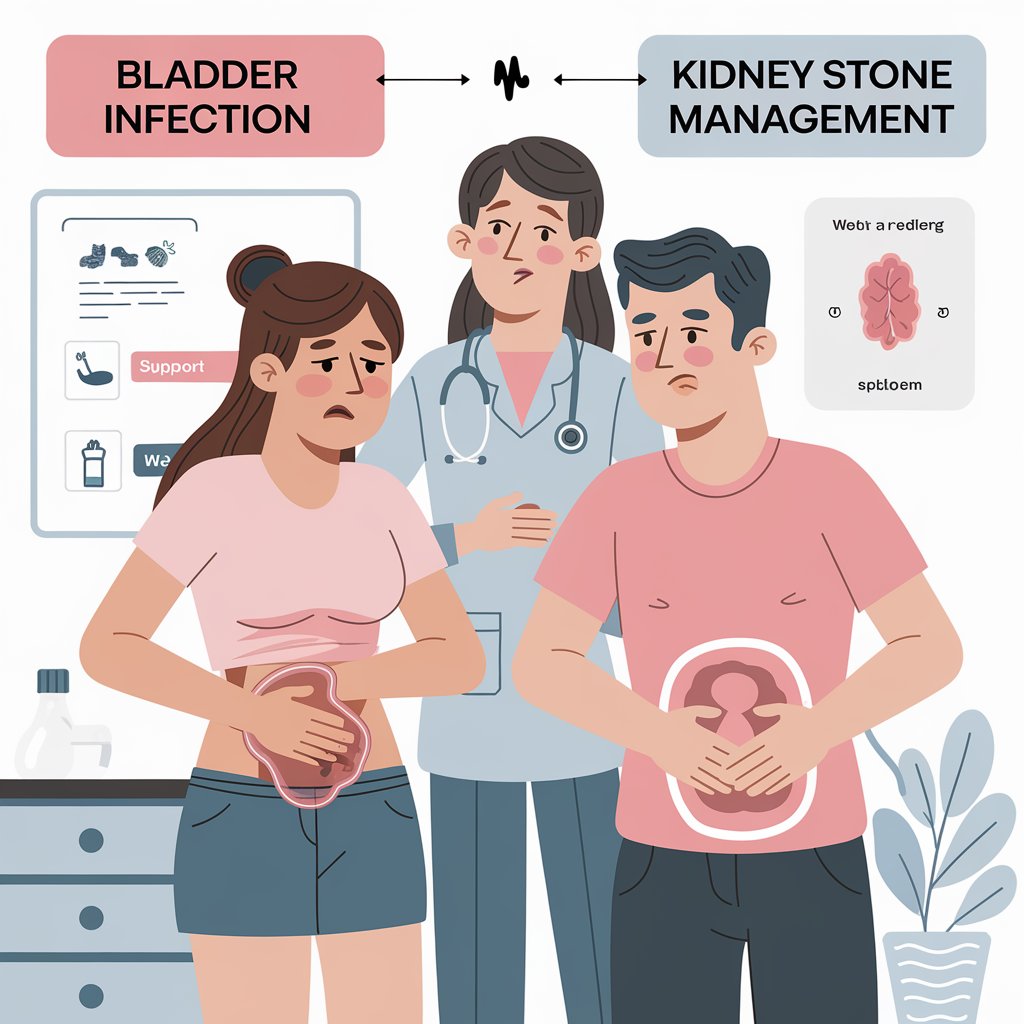Bladder Infection vs Kidney Stones: Understanding the Key Differences
When it comes to urinary health, bladder infections and kidney stones are two common but very different conditions that affect the urinary tract. While both can cause significant discomfort, it’s important to understand the differences between these two conditions to ensure that you’re receiving the right treatment. In this article, we’ll break down what bladder infections and kidney stones are, how to recognize their symptoms, and what sets them apart from each other.
What Are Bladder Infections?
A bladder infection is a type of urinary tract infection (UTI) that specifically affects the bladder, a hollow organ that stores urine. UTIs are usually caused by bacteria entering the urinary tract through the urethra, which is the tube that carries urine out of the body.
Symptoms of a Bladder Infection:
- Frequent urination: You may feel the urge to urinate more often than usual, and sometimes only pass small amounts.
- Pain or burning during urination: A common symptom of UTIs and bladder infections.
- Cloudy or strong-smelling urine: This can indicate infection.
- Pelvic pain: Discomfort or pressure in the lower abdomen.
- Blood in urine: In more severe cases, you might notice blood in your urine.
Pain Management for UTIs
- Antibiotics: UTIs are bacterial infections, so antibiotics are the primary treatment. They address the root cause of the pain.
- Over-the-Counter Pain Relievers: Medications like phenazopyridine (e.g., Azo) can provide temporary relief from urinary pain and burning.
- Hydration: Drinking water helps flush out bacteria from the urinary tract and can alleviate symptoms.
- Heat Therapy: Applying a heating pad to the lower abdomen can help relieve discomfort.
What Are Kidney Stones?
Kidney stones, on the other hand, are small, hard mineral deposits that form in the kidneys. These stones can range in size from tiny grains to large, rock-like formations. When kidney stones move through the urinary tract, they can cause severe pain.
Symptoms of Kidney Stones:
- Sharp, intense pain: Kidney stones can cause extreme pain, often described as the most excruciating pain someone can experience. This pain is usually felt in the lower back or side and may radiate to the groin or abdomen.
- Pain during urination: If the stone moves into the urethra, you may experience a sharp, burning sensation while urinating.
- Frequent urination: Like a bladder infection, kidney stones can also cause you to urinate more often.
- Blood in urine: When a kidney stone moves or when it causes damage to the urinary tract, blood may appear in the urine.
- Nausea and vomiting: Severe pain from kidney stones may be accompanied by nausea or vomiting.
Pain Management for Kidney Stones
- Hydration: Drinking plenty of water helps flush out smaller stones. Staying hydrated can also prevent new stones from forming.
- Pain Relievers: Over-the-counter medications like ibuprofen or acetaminophen can help manage mild to moderate pain. For severe pain, doctors may prescribe stronger medications.
- Medications to Relax the Ureter: Drugs like tamsulosin (Flomax®) or nifedipine may be prescribed to relax the ureter and help stones pass more easily.
- Medical Procedures: If the stones are too large to pass, treatments like shock wave lithotripsy, ureteroscopy, or percutaneous nephrolithotomy may be necessary
Bladder Infection vs Kidney Stones: Key Differences

While both bladder infections and kidney stones can cause urinary symptoms, the nature of the pain, location, and associated symptoms are often different.
1. Pain Location:
- Bladder Infection: The pain is typically located in the lower abdomen and pelvic area. The discomfort during urination is also common.
- Kidney Stones: Pain from kidney stones is usually felt in the back or side, just below the ribs. It can also radiate to the lower abdomen or groin.
2. Pain Intensity:
- Bladder Infection: Pain from a bladder infection is often mild to moderate, especially during urination. It may cause a sensation of urgency, but it is generally less intense.
- Kidney Stones: The pain from kidney stones, especially when the stone moves through the urinary tract, is sharp, severe, and can be described as excruciating. Kidney stone pain can be much more intense than a UTI or bladder infection.
3. Blood in Urine:
- Bladder Infection: Blood in the urine with a bladder infection is less common but can occur, especially in more severe cases.
- Kidney Stones: Blood in the urine is common with kidney stones and may be visible to the naked eye (hematuria). This happens because the stone may scrape the walls of the urinary tract, causing bleeding.
4. Other Symptoms:
- Bladder Infection: Bladder infections often come with symptoms like urgency, cloudy urine, or strong-smelling urine.
- Kidney Stones: In addition to pain and blood in the urine, kidney stones can cause nausea, vomiting, and even fever if the stone leads to an infection.
Kidney Stones vs UTI: Which Hurts More?
Many people wonder whether kidney stone pain or UTI pain is worse. In general, kidney stone pain is much more intense and can be described as severe and sharp. On the other hand, a UTI or bladder infection typically causes discomfort, burning, and a frequent urge to urinate, but it is usually not as excruciating as kidney stone pain.
Male UTI vs Kidney Stone: What’s the Difference?
When comparing a male UTI vs kidney stone, the symptoms are similar in some ways but distinct in others. For example, a male with a UTI might experience painful urination, frequent urination, and possibly a fever. However, kidney stones in men tend to cause more severe pain, particularly in the back, side, and groin areas, and are often accompanied by nausea and vomiting.
Can Kidney Stones Cause UTIs?
Yes, kidney stones can lead to infections. When a kidney stone causes a blockage in the urinary tract, it creates a perfect environment for bacteria to grow, which can lead to a urinary tract infection (UTI). Kidney stones with a bladder infection or kidney stones with UTI are common occurrences when the stone interferes with normal urine flow, potentially trapping bacteria in the bladder.
The Difference Between Kidney Infection and Bladder Infection
Both kidney infections and bladder infections are types of UTIs, but they affect different parts of the urinary system. A kidney infection (pyelonephritis) occurs when bacteria travel up to the kidneys, causing pain in the back or side and often accompanied by fever, chills, and nausea. A bladder infection (cystitis), however, affects the lower urinary tract and typically causes pain in the pelvic area, frequent urination, and burning during urination.
Kidney Stones and Urinary Tract Symptoms
While kidney stones themselves do not cause UTIs, they can contribute to nephrolithiasis from UTI when a stone forms after an infection. Kidney stones might also be mistaken for a UTI because both conditions share some common symptoms like frequent urination, burning, and discomfort. However, the pain associated with kidney stones is typically much more severe and is often accompanied by nausea, vomiting, and sharp pain in the lower back or side.
Can Kidney Stones Cause Fever?
A fever can develop if a kidney stone causes an infection in the urinary tract. This condition, known as pyelonephritis, occurs when bacteria reach the kidneys, leading to a kidney infection. Symptoms of a kidney infection may include fever, chills, back pain, and nausea. If you experience these symptoms along with kidney stone pain, seek medical attention immediately.
Can Kidney Stones Cause Burning During Urination?
Yes, kidney stones burning urethra can occur when the stone moves through the urinary tract and irritates the urethra or bladder. The burning sensation while urinating is similar to that experienced in a UTI, but in this case, the burning is due to the stone’s physical presence rather than infection.
Conclusion: Understanding the Differences
While both bladder infections and kidney stones can cause urinary discomfort and even overlap in some symptoms, they are distinct conditions that require different treatments. Bladder infections are typically treated with antibiotics, while kidney stones often require pain management and may sometimes require medical procedures to remove the stones.
If you’re experiencing symptoms like frequent urination, pain while urinating, or blood in your urine, it’s important to visit a healthcare professional. Kidney stones vs infection can sometimes be difficult to differentiate, so proper diagnosis is essential for getting the right treatment.
Understanding the difference between kidney stones and bladder infections, along with knowing the symptoms of each, can help you address the issue early and avoid more serious complications in the future.
Final Thoughts
Both bladder infections and kidney stones affect the urinary tract, but the causes, symptoms, and treatments are different. Whether you’re dealing with kidney stones or a bladder infection, seeking timely medical advice is crucial. If you’re unsure whether your symptoms are related to kidney stones, a UTI, or another issue, don’t hesitate to reach out to a healthcare provider.
By learning about these two conditions, you’re taking the first step in maintaining better urinary health and avoiding complications.

